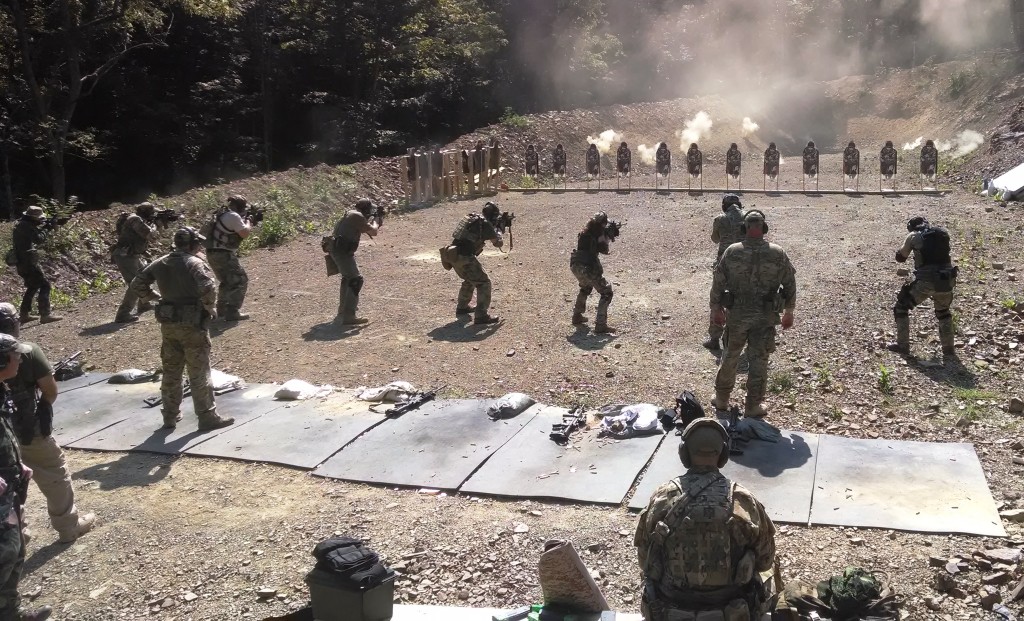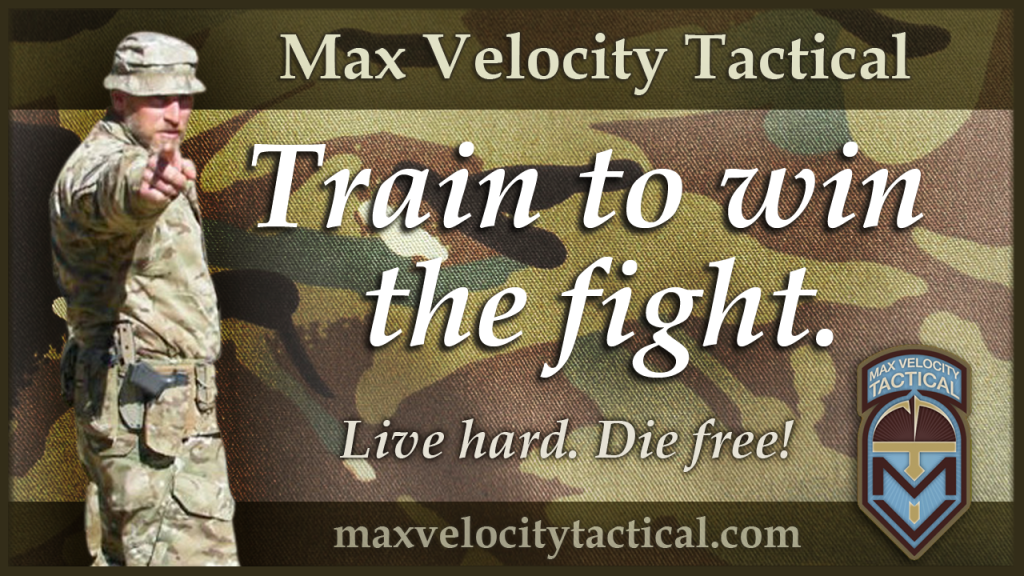Student Review: Virginia Combat Team Tactics July: Larry
Max Velocity Tactical’s Combat Team Tactics (CTT) is three days, in a 100-acre training area in the rugged terrain of West Virginia. The first day is on a “square” range, the other two days are out in the training area (see description below).
General notes: The instructors are quite experienced, with decades of time spent in the British Paras, U.S. Army Infantry, and as PMCs. Max and his staff are always focused on safety and ensuring that you get quality instruction. Round count was just under 1,000 for me (but I’m not sparing – it’s not often you get a training opportunity like this, and if I have a shot on a target, then I am taking it – you can use less if you wish.)
Situational awareness, and communicating/coordinating with other people while firing and moving, is HARD; that is what the class is all about. You really have no idea unless you have done it. Identifying targets, putting good aimed fire on targets, reloading, clearing malfunctions, etc., takes time, but on top of that you need to find time to figure out where your buddy/buddies are, what they are doing, are they ok, where your next piece of cover is, who needs to move, communicating what needs to happen, figuring out if your buddies actually heard you and are doing what you expected… it’s not easy. The targets are pop-ups, controlled remotely by the instructor, and can pop-up, stay down for a while, pop up again… and are spread throughout the training area – left, right, center, and in depth – and you are MOVING through the area…
Day One:
This day is focused on ensuring everyone has the level of individual skills required to function effectively within a team – it ensures that the time spent out in the training areas is not wasted with remedial instruction or weapon malfunctions. The day begins with confirming zero, (then instruction in combat reloads, tactical reloads and malfunction clearance), then the class splits into two groups for malfunction drills. One group goes to the bottom of the hill and the other sets up a malfunction, then the first group has to run up the hill, pick up their weapons and attempt to fire an aimed shot, then clear the malfunction and fire two aimed shots. (Heh, I managed to inadvertently clear a stovepipe while picking up my weapon – and I didn’t even realize it – fortunately I did take a good aimed shot!)
This is followed by reacting to targets from various directions (facing movements/ready ups) – look at the target, turn your body, then bring up your weapon (so that you aren’t muzzle sweeping your teammates). Usually the drill involved two quick aimed shots, take a knee (or prone), and two well-aimed shots to finish the engagement. Time very well spent to ensure the next two days flow smoothly out in the training area and ensures you don’t just have “your head in your weapon” the whole time, when you are supposed to be maintaining situational awareness. (finishing up the day with RTR reaction drills)
Day Two:
Day two is out in the training areas – working as a buddy team (2 people) or a fire team with 2 buddy pairs (4 people total). It really stresses your situational awareness and communications skills – you are in the woods, with pop-up targets – so you have to actually SEE where your buddy is, and where the targets are – and that isn’t always easy with foliage and rough terrain (hey, it’s West Virginia, not the plains of Kansas, it’s surprising how a little bump in the terrain can totally mask your fire). There are different scenarios for either advancing and clearing enemy positions, or withdrawing and breaking contact, with various numbers of targets and buddies. It’s all fun and games until you have two targets and your buddies’ weapon just went down – now you have two targets to service while your buddy gets things sorted out. There is a block of instruction on the effective use of cover – with some very good tips that you can immediately put to use in the rough terrain.
Day Three:
This begins with the Jungle Walk. You are in a new part of the training area, so you haven’t seen the terrain yet, and you don’t know where the targets will pop up. It’s pretty intense – this is the only solo part of the course, and is really meant to test your abilities to react and move. The rest of the day is buddy pair and fire team scenarios through the area, against more pop-ups. This is where I finally found the time to really gain situational awareness, and do a much better job analyzing the situation and communicating (but all very quickly!), moving within a team, and good use of cover. Ok, better use of cover – that skill takes practice, when you have to move fast.
The day culminates in a squad attack that the whole class participates in (12 people in this case). It’s amazing – moving up to contact, setting up support by fire positions, maneuvering to the flank, shifting fires, assaulting the objective. This is the real deal, and it’s amazing.
Overall, the instruction and practice you get in situational awareness, communication, fire and movement, and use of cover makes the class well worthwhile. It’s also a good chance to see how your gear actually performs when it isn’t sitting in the corner of your closet. On top of that, it’s a fantastic experience that I think everyone should experience at least once in their lifetime.
Fred’s CBRN Defense class:
This is a bonus feature, and it is completely amazing. Don’t say it can’t happen here: the first time I took this class was when Ebola had reached the U.S., so I paid rapt attention and wow did I ever learn. (Heck, West Virginia has even been the site of trains derailing, and spilling chemicals.) While students rotate through the Jungle Walk, everyone else gets a block of instruction from an expert in the field of CBRN (Chem/Bio/Rad/Nuke). Fred is an actual scientist with both theoretical and practical knowledge of the subject. His class aims to impart practical knowledge of what you can do if faced with one of these threats. How to know when something is dangerous, how to disinfect/decontaminate the various threats, how to care for a loved one if something really bad happens and the hospitals are overwhelmed. Fred goes far, far beyond the very basic CBRN training you get in the Army. Heck, between my crazy, awesome Organic Chemistry professor and my dad (who worked in the field for years), I know much more than the average person, and I still learned a lot from Fred.


